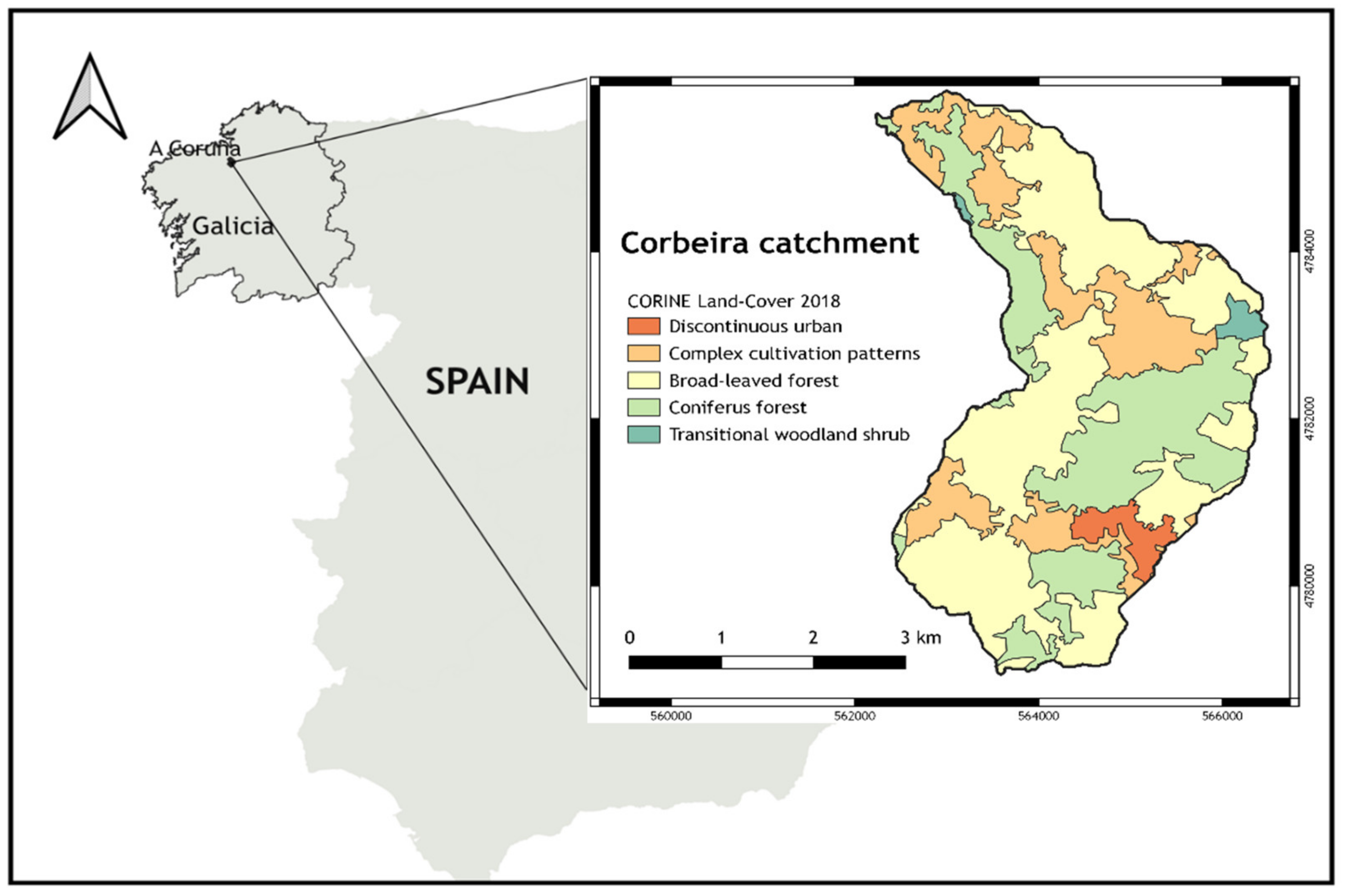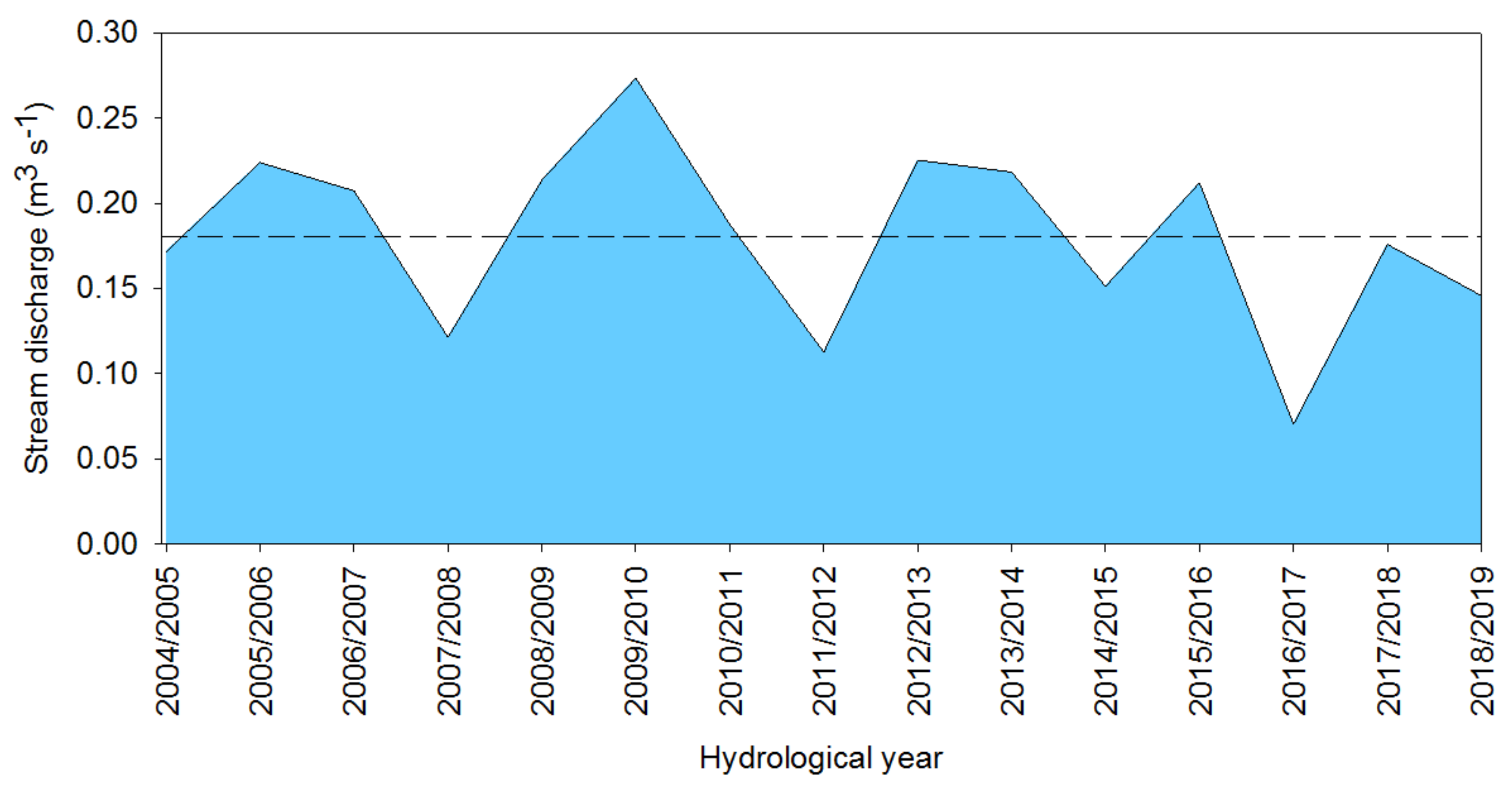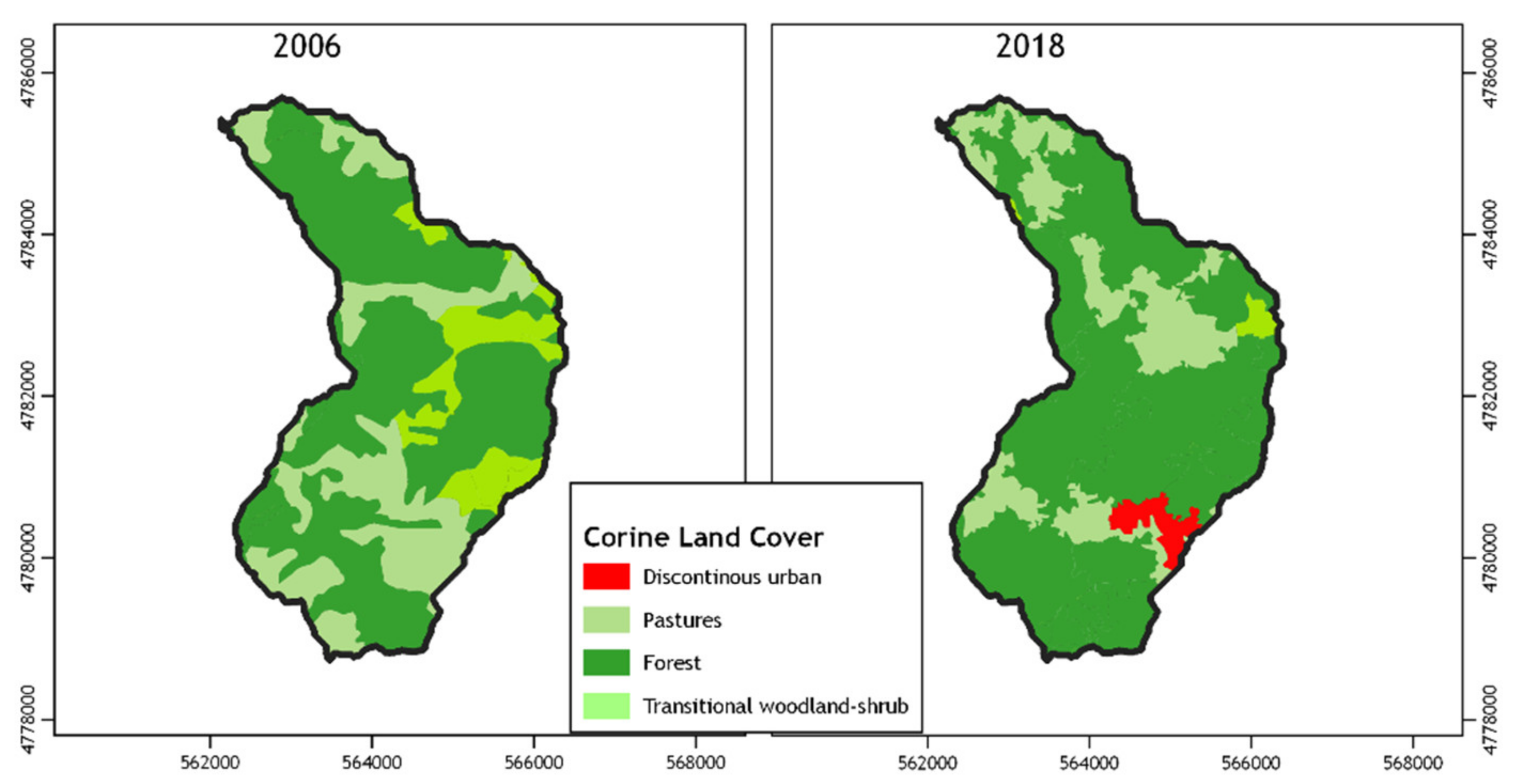An Assessment of the Recent Evolution of the Streamflow in a Near-Natural System: A Case Study in the Headwaters of the Mero Basin (Galicia, Spain)
Abstract
1. Introduction
2. Materials and Methods
2.1. Case Study and Data Description
2.2. Instrumentation and Dataset
2.3. Data Processing and Analysis
3. Results
3.1. Statistical Characteristics of the Climatic Conditions and Streamflow
3.2. Land Use Changes
3.3. Trend Analysis of Climatic Variables and Stream Discharge
3.4. Trend in Low and High Flows
4. Discussion
5. Summary and Final Remarks
Author Contributions
Funding
Conflicts of Interest
References
- Villarini, G.; Smith, J.A.; Serinaldi, F.; Ntelekos, A.A. Analyses of seasonal and annual maximum daily discharge records for central Europe. J. Hydrol. 2011, 399, 299–312. [Google Scholar] [CrossRef]
- Svensson, C.; Kundzewicz, W.Z.; Maurer, T. Trend detection in river flow series: 2. Flood and low-flow index series. Hydrol. Sci. J. 2005, 50, 1–824. [Google Scholar] [CrossRef]
- Wagener, T.; Wheater, H.; Gupta, H.V. Rainfall-Runoff Modelling in Gauged and Ungauged Catchments; World Scientific: Singapore, 2004. [Google Scholar]
- Moradkhani, H.; Sorooshian, S. General Review of Rainfall-Runoff Modeling: Model Calibration, Data Assimilation, and Uncertainty Analysis. In Water Science and Technology Library; Springer: Berlin/Heidelberg, Germany, 2008; Volume 63, pp. 1–24. [Google Scholar]
- De Paola, F.; Giugni, M.; Pugliese, F.; Annis, A.; Nardi, F. GEV Parameter Estimation and Stationary vs. Non-Stationary Analysis of Extreme Rainfall in African Test Cities. Hydrology 2018, 5, 28. [Google Scholar] [CrossRef]
- Hannaford, J.; Marsh, T.J. High-flow and flood trends in a network of undisturbed catchments in the UK. Int. J. Clim. 2008, 28, 1325–1338. [Google Scholar] [CrossRef]
- Bertola, M.; Viglione, A.; Lun, D.; Hall, J.; Blöschl, G. Flood trends in Europe: Are changes in small and big floods different? Hydrol. Earth Syst. Sci. 2020, 24, 1805–1822. [Google Scholar] [CrossRef]
- Stahl, K.; Hisdal, H.; Hannaford, J.; Tallaksen, L.M.; Van Lanen, H.A.J.; Sauquet, E.; DeMuth, S.; Fendekova, M.; Jódar, J. Streamflow trends in Europe: Evidence from a dataset of near-natural catchments. Hydrol. Earth Syst. Sci. 2010, 14, 2367–2382. [Google Scholar] [CrossRef]
- Morán-Tejeda, E.; Lorenzo-Lacruz, J.; López-Moreno, J.I.; Rahman, K.; Beniston, M. Streamflow timing of mountain rivers in Spain: Recent changes and future projections. J. Hydrol. 2014, 517, 1114–1127. [Google Scholar] [CrossRef]
- Masseroni, D.; Camicis, S.; Cislaghi, A.; Vacchiano, G.; Massari, C.; Brocca, L. 65-year change of annual streamflow volumes across Europe with a focus on the Mediterranean basin. Hydrol. Earth Syst. Sci. 2020, 1–16. [Google Scholar] [CrossRef]
- Bermúdez, M.; Neal, J.; Bates, P.; Coxon, G.; Freer, J.E.; Cea, L.; Puertas, J. Quantifying local rainfall dynamics and uncertain boundary conditions into a nested regional-local flood modeling system. Water Resour. Res. 2017, 53, 2770–2785. [Google Scholar] [CrossRef]
- Annis, A.; Nardi, F.; Volpi, E.; Fiori, A. Quantifying the relative impact of hydrological and hydraulic modelling parameterizations on uncertainty of inundation maps. Hydrol. Sci. J. 2020, 65, 507–523. [Google Scholar] [CrossRef]
- LeRoy Poff, N.; Allan, J.D.; Bain, M.B.; Karr, J.R.; Prestegaard, K.L.; Richter, B.D.; Sparks, R.E.; Stromberg, J.C. The natural flow regime: A paradigm for river conservation and restoration. BioScience 1997, 47, 769–784. [Google Scholar] [CrossRef]
- Chaves, M.L.; Costa, J.L.; Chainho, P.; Costa, M.J.; Prat, N. Selection and validation of reference sites in small river basins. Hydrobiology 2006, 573, 133–154. [Google Scholar] [CrossRef]
- Richter, B.D.; Baumgartner, J.V.; Powell, J.; Braun, D.P. A Method for Assessing Hydrologic Alteration within Ecosystems. Conserv. Biol. 1996, 10, 1163–1174. [Google Scholar] [CrossRef]
- Grill, G.; Lehner, B.; Thieme, M.; Geenen, B.; Tickner, D.; Antonelli, F.; Babu, S.; Borrelli, P.; Cheng, L.; Crochetiere, H.; et al. Mapping the world’s free-flowing rivers. Nature 2019, 569, 215–221. [Google Scholar] [CrossRef] [PubMed]
- Batalla, R.J.; Gómez, C.M.G.; Kondolf, G. Reservoir-induced hydrological changes in the Ebro River basin (NE Spain). J. Hydrol. 2004, 290, 117–136. [Google Scholar] [CrossRef]
- Nardi, F.; Morrison, R.R.; Annis, A.; Grantham, T.E. Hydrologic scaling for hydrogeomorphic floodplain mapping: Insights into human-induced floodplain disconnectivity. River Res. Appl. 2018, 34, 675–685. [Google Scholar] [CrossRef]
- Scheel, K.; Morrison, R.R.; Annis, A.; Nardi, F. Understanding the Large-Scale Influence of Levees on Floodplain Connectivity Using a Hydrogeomorphic Approach. JAWRA J. Am. Water Resour. Assoc. 2019, 55, 413–429. [Google Scholar] [CrossRef]
- Martínez-Fernández, J.; Sánchez, N.; Herrero-Jiménez, C.M. Recent trends in rivers near-natural flow regime: The case of the river headwaters in Spain. Prog. Phys. Geogr. 2013, 37, 685–700. [Google Scholar] [CrossRef]
- Buendia, C.; Bussi, G.; Tuset, J.; Vericat, D.; Sabater, S.; Palau, A.; Batalla, R.J. Effects of afforestation on runoff and sediment load in an upland Mediterranean catchment. Sci. Total. Environ. 2016, 540, 144–157. [Google Scholar] [CrossRef]
- Lorenzo-Lacruz, J.; Serrano, S.M.V.; López-Moreno, J.I.; Morán-Tejeda, E.; Zabalza, J. Recent trends in Iberian streamflows (1945–2005). J. Hydrol. 2012. [Google Scholar] [CrossRef]
- Wilson, D.; Hisdal, H.; Lawrence, D. Has streamflow changed in the Nordic countries?—Recent trends and comparisons to hydrological projections. J. Hydrol. 2010, 394, 334–346. [Google Scholar] [CrossRef]
- Zabaleta, A.; Morales, T.; Meaurio, M.; Gorria, C.; Antigüedad, I. Regional Hydrological Signs for Climate Change in Southern Europe (Basque Country). In Proceedings of the International Conference on Water, Climate and Environment (Balwois), Ohrid, Republic of Macedonia, 28 May–2 June 2012. [Google Scholar]
- Lorenzo-Lacruz, J.; Serrano, S.M.V.; López-Moreno, J.I.; Beguería, S.; García-Ruiz, J.M.; Cuadrat, J.M. The impact of droughts and water management on various hydrological systems in the headwaters of the Tagus River (central Spain). J. Hydrol. 2010, 386, 13–26. [Google Scholar] [CrossRef]
- Morán-Tejeda, E.; López-Moreno, J.I.; Barbancho, A.C.; Vicente-Serrano, S.M. River regimes and recent hydrological changes in the Duero basin (Spain). J. Hydrol. 2011, 404, 241–258. [Google Scholar] [CrossRef]
- Hawtree, D.; Nunes, J.P.; Keizer, J.J.; Jacinto, R.; Santos, J.; Rial-Rivas, M.E.; Karine-Boulet, A.; Tavares-Wahren, F.; Feger, K.-H. Time series analysis of the long-term hydrologic impacts of afforestation in the Águeda watershed of north-central Portugal. Hydrol. Earth Syst. Sci. 2015, 19, 3033–3045. [Google Scholar] [CrossRef]
- Lago, A.; Lage, A.; Cruz, R.; Pérez-Muñurizi, V. Estudo das varia- cións de temperatura e precipitación en Galicia nos últimos trinta anos no contexto do cambio climático global. Rev. Real Acad. Galega Cienc. 2006, 25, 27–58. [Google Scholar]
- Rodrigo, F.S.; Trigo, R.M. Trends in daily rainfall in the Iberian Peninsula from 1951 to 2002. Int. J. Clim. 2007, 27, 513–529. [Google Scholar] [CrossRef]
- Instituto Tecnologico Geominero de Espana (IGME). Mapa GeoloÅLgico de Espana, 1:50,000; Hoja 45: Betanzos, Spain, 1981. [Google Scholar]
- IUSS Working Group WRB. World Reference Base for Soil Resources 2014, Update 2015: International Soil Classification System for Naming Soils and Creating Legends for Soil Maps; World Soil Resources Reports No. 106; FAO: Rome, Italy, 2015. [Google Scholar]
- Ouarda, T.B.M.J.; Charron, C.; St-Hilaire, A. Statistical Models and the Estimation of Low Flows. Can. Water Resour. J. Rev. Can. Ressour. Hydrol. 2008, 33, 195–206. [Google Scholar] [CrossRef]
- Salmi, T.; Määttä, A.; Anttila, P.; Ruoho-Airola, T.; Amnell, T. Detecting Trends of Annual Values of Atmospheric Pollutants by the Mann-Kendall Test and Sen’s Slope Estimates—The Excel Template Application MAKESEN; Publication on Air Quality No 31; Air Quality Research; Finnish Meteorological Institute: Helsinki, Finland, 2002. [Google Scholar]
- Gilbert, R.O. Statistical Methods for Environmental Pollution Monitoring; John Wiley & Sons: Hoboken, NJ, USA, 1987. [Google Scholar]
- Fathian, F.; Dehghan, Z.; Bazrkar, M.H.; Eslamian, S. Trends in hydrological and climatic variables affected by four variations of the Mann-Kendall approach in Urmia Lake basin, Iran. Hydrol. Sci. J. 2016, 61, 1–13. [Google Scholar] [CrossRef]
- Forootan, E. Analysis of trends of hydrologic and climatic variables. Soil Water Res. 2019, 14, 163–171. [Google Scholar] [CrossRef]
- Kundzewicz, Z.W.; Graczyk, D.; Maurer, T.; Pińskwar, I.; Radziejewski, M.; Svensson, C.; Szwed, M. Trend detection in river flow series: 1. Annual maximum flow/Détection de tendance dans des séries de débit fluvial: 1. Débit maximum annuel. Hydrol. Sci. J. 2005, 50, 797–810. [Google Scholar] [CrossRef]
- Palleiro, L.; Rodríguez-Blanco, M.; Taboada-Castro, M.M.; Taboada-Castro, M.T. Hydrological response of a humid agroforestry catchment at different time scales. Hydrol. Process. 2013, 28, 1677–1688. [Google Scholar] [CrossRef]
- Rodríguez-Blanco, M.; Taboada-Castro, M. An overview of patterns and dynamics of suspended sediment transport in an agroforest headwater system in humid climate: Results from a long-term monitoring. Sci. Total. Environ. 2019, 648, 33–43. [Google Scholar] [CrossRef] [PubMed]
- Jones, J.; Creed, I.F.; Hatcher, K.L.; Warren, R.J.; Adams, M.B.; Benson, M.H.; Boose, E.; Brown, W.A.; Campbell, J.L.; Covich, A.; et al. Ecosystem Processes and Human Influences Regulate Streamflow Response to Climate Change at Long-Term Ecological Research Sites. Bioscience 2012, 62, 390–404. [Google Scholar] [CrossRef]
- Moreira, F.; Rego, F.C.; Ferreira, P.G. Temporal (1958–1995) pattern of change in a cultural landscape of northwestern Portugal: Implications for fire occurrence. Landsc. Ecol. 2001, 16, 557–567. [Google Scholar] [CrossRef]
- Fuchs, R.; Herold, M.; Verburg, P.H.; Clevers, J.G.; Eberle, J. Gross changes in reconstructions of historic land cover/use for Europe between 1900 and 2010. Glob. Chang. Biol. 2014, 21, 299–313. [Google Scholar] [CrossRef] [PubMed]
- Del Río, S.; Herrero, L.; Pinto-Gomes, C.; Penas, Á. Spatial analysis of mean temperature trends in Spain over the period 1961–2006. Glob. Planet. Chang. 2011, 78, 65–75. [Google Scholar] [CrossRef]





| Rainfall | Temperature | |||||
|---|---|---|---|---|---|---|
| Mann–Kendall Trend | Sen’s Slope Estimate | Mann–Kendall Trend | Sen’s Slope Estimate | |||
| Test Z | Significance | Q | Test Z | Significance | Q | |
| Annual | 1.48 | 5.242 | 3.69 | *** | 0.037 | |
| Autumn | 0.61 | 1.989 | 1.35 | 0.027 | ||
| Winter | 1.43 | 3.688 | 1.79 | + | 0.027 | |
| Spring | −0.15 | −0.198 | 3.81 | *** | 0.055 | |
| Summer | −0.25 | −0.208 | 2.60 | ** | 0.036 | |
| October | 0.69 | 0.873 | 1.87 | + | −0.017 | |
| November | 1.40 | 2.219 | 0.31 | 0.009 | ||
| December | −1.08 | −0.980 | 0.28 | 0.007 | ||
| January | 0.67 | 0.884 | 2.10 | * | 0.048 | |
| February | 1.38 | 1.453 | 0.11 | 0.003 | ||
| March | 1.35 | 1.157 | 1.96 | + | 0.027 | |
| April | 0.01 | 0.017 | 2.33 | * | 0.061 | |
| May | −0.04 | −0.042 | 2.16 | * | 0.048 | |
| June | 0.48 | 0.257 | 3.29 | *** | 0.068 | |
| July | 0.71 | 0.164 | 2.06 | * | 0.040 | |
| August | 1.20 | 0.372 | 2.13 | * | 0.033 | |
| September | −1.27 | −0.902 | 1.05 | 0.029 | ||
| Mann–Kendall Trend | Sen’s Slope Estimate | ||
|---|---|---|---|
| Test Z | Significance | Q | |
| Annual | −1.09 | −0.004 | |
| Autumn | −2.28 | * | −0.011 |
| Winter | 0.20 | 0.002 | |
| Spring | −0.49 | −0.003 | |
| Summer | −2.67 | ** | −0.003 |
| October | −2.57 | * | −0.008 |
| November | −1.19 | −0009 | |
| December | 1.68 | + | −0.020 |
| January | 0.00 | −0.001 | |
| February | 0.79 | 0.011 | |
| March | 0.20 | 0.003 | |
| April | −0.49 | −0.005 | |
| May | −1.09 | −0.005 | |
| June | −1.29 | −0.005 | |
| July | −1.39 | −0.004 | |
| August | −2.28 | * | −0.003 |
| September | −2.67 | ** | −0.004 |
| Mann–Kendall Trend | Sen’s Slope Estimate | |||
|---|---|---|---|---|
| Test Z | Significance | Q | ||
| Annual | Q10 | 2.79 | ** | 6.875 |
| Q20 | 3.07 | ** | 8.429 | |
| Severity (Q10) | 2.90 | ** | 9.379 | |
| Severity (Q20) | 1.48 | ** | 0.011 | |
| Q80 | −0.84 | −1.000 | ||
| Q90 | −0.10 | −0.333 | ||
| Autumn | Q10 | 2.59 | ** | 1.00 |
| Q20 | 2.38 | * | 3.00 | |
| Q80 | −1.50 | −1.444 | ||
| Q90 | −1.89 | + | −0.250 | |
| Winter | Q10 | 1.04 | 0.000 | |
| Q20 | 0.17 | 0.000 | ||
| Q80 | 0.25 | 1.000 | ||
| Q90 | 0.40 | 0.222 | ||
| Spring | Q20 | 1.04 | 0.000 | |
| Q80 | −1.19 | −0.667 | ||
| Q90 | −0.25 | 0.000 | ||
| Summer | Q10 | 2.24 | * | 4.200 |
| Q20 | 2.31 | * | 4.200 | |
| October | Q10 | 2.88 | ** | 0.875 |
| Q20 | 2.38 | * | 1.556 | |
| Q80 | −2.38 | * | 0.000 | |
| November | Q10 | 1.49 | 0.000 | |
| Q20 | 1.80 | + | 0.000 | |
| Q80 | −1.88 | + | −0.727 | |
| Q90 | −1.64 | 0.000 | ||
| December | Q20 | 1.22 | 0.000 | |
| Q80 | −1.72 | + | −0.889 | |
| Q90 | −1.69 | + | 0.000 | |
| January | Q20 | 0.17 | 0.000 | |
| Q80 | 0.80 | 0.182 | ||
| Q90 | 0.68 | 0.000 | ||
| February | Q80 | 0.75 | 0.400 | |
| Q90 | 0.65 | 0.000 | ||
| March | Q80 | −0.05 | 0.000 | |
| April | Q80 | −0.15 | −0.125 | |
| Q90 | −0.10 | 0.000 | ||
| May | Q80 | −0.65 | 0.000 | |
| June | Q80 | −1.00 | 0.000 | |
| July | Q10 | 1.14 | 0.000 | |
| Q20 | 1.94 | + | 0.571 | |
| August | Q10 | 2.52 | * | 1.385 |
| Q20 | 2.40 | * | 1.333 | |
| September | Q10 | 2.68 | ** | 2.231 |
| Q20 | 2.35 | * | 1.000 | |
Publisher’s Note: MDPI stays neutral with regard to jurisdictional claims in published maps and institutional affiliations. |
© 2020 by the authors. Licensee MDPI, Basel, Switzerland. This article is an open access article distributed under the terms and conditions of the Creative Commons Attribution (CC BY) license (http://creativecommons.org/licenses/by/4.0/).
Share and Cite
Rodríguez-Blanco, M.L.; Taboada-Castro, M.M.; Taboada-Castro, M.T. An Assessment of the Recent Evolution of the Streamflow in a Near-Natural System: A Case Study in the Headwaters of the Mero Basin (Galicia, Spain). Hydrology 2020, 7, 97. https://doi.org/10.3390/hydrology7040097
Rodríguez-Blanco ML, Taboada-Castro MM, Taboada-Castro MT. An Assessment of the Recent Evolution of the Streamflow in a Near-Natural System: A Case Study in the Headwaters of the Mero Basin (Galicia, Spain). Hydrology. 2020; 7(4):97. https://doi.org/10.3390/hydrology7040097
Chicago/Turabian StyleRodríguez-Blanco, M. L., M. M. Taboada-Castro, and M. T. Taboada-Castro. 2020. "An Assessment of the Recent Evolution of the Streamflow in a Near-Natural System: A Case Study in the Headwaters of the Mero Basin (Galicia, Spain)" Hydrology 7, no. 4: 97. https://doi.org/10.3390/hydrology7040097
APA StyleRodríguez-Blanco, M. L., Taboada-Castro, M. M., & Taboada-Castro, M. T. (2020). An Assessment of the Recent Evolution of the Streamflow in a Near-Natural System: A Case Study in the Headwaters of the Mero Basin (Galicia, Spain). Hydrology, 7(4), 97. https://doi.org/10.3390/hydrology7040097






